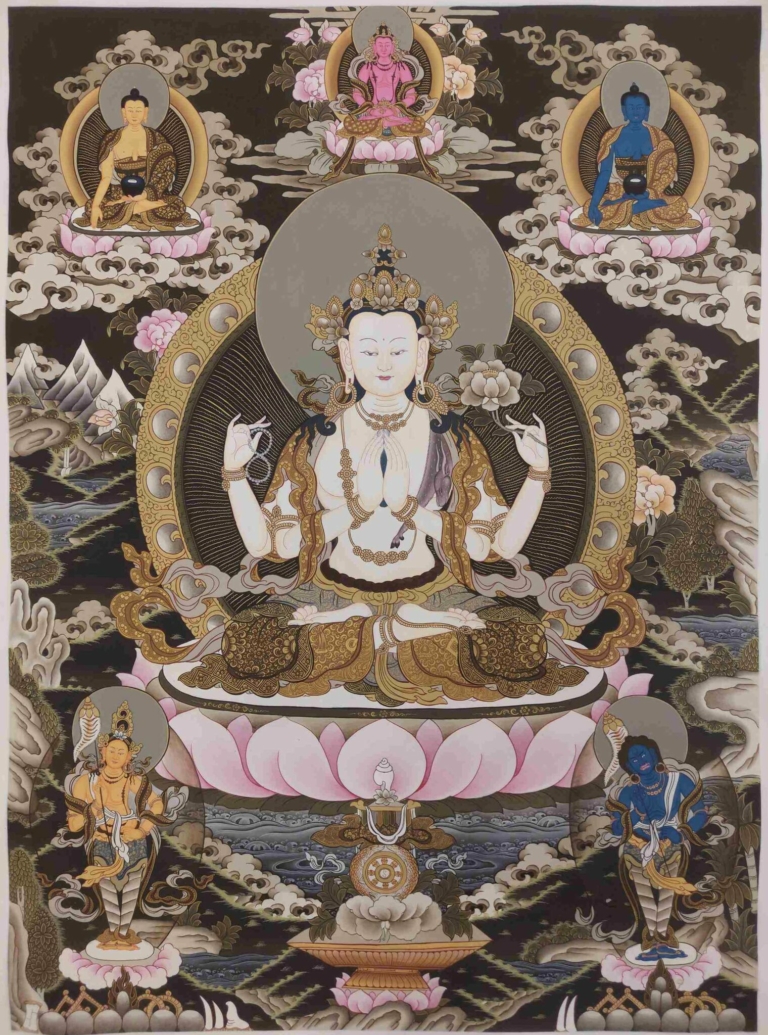Description
Chenrezig with Medicine Buddha Thangka art is hand painted on cotton canvas by a thangka artist from Nepal. The size of this thangka is 75 x 54cm and its weight is 0.1kg. Chenrezig is the most revered of all Bodhisattva embodying the compassion of all Buddhas.
Chenrezig is depicted in the center of the thangka. Shakyamuni Buddha and Medicine Buddha are presented at the top left and top right corner of the Chenrezig in the thangka. Vajrasattva is presented at the top of the Chenrezig in the thangka. Two standing gods are presented at the bottom left and down the corner of the Chenrezig in the thangka.
| Weight | 100 Grams |
| Size | 62 x 45 cm |
| Material | Cotton Canvas and Mineral Color |
Iconography of Chenrezig
Chenrezig is presented at the center of the Chenrezig. Chenrezig Tibetan Art is visualized in many forms with various numbers of faces and arms, and various colors and ornaments. He sits on a lotus and the flat disc of the moon with another moon disk behind him, reflecting his total purity.
Two of his four arms are joined in the prayer position holding the wish-fulfilling gem. In his other left hand, he holds a lotus flower and in his other right hand, there is a crystal mala which he is using to count the repetitions of his mantra.
Chenrezig Mantra
The Chenrezig mantra is Om Mani Padme Hum.
Iconography of Vajrasattva
Vajrasattva is presented at the top of the Chenrezig in the thangka. Vajrasattva is pure white in color and is sometimes known as the Prince of Purity. His name means “Adamantine Being”, or more poetically “Embodying Reality”.
He is a member of the Vajra family of Aksobhya which also includes Vajrapani. He is depicted as a young man in the prime of life, with all the silks and jewels of a wealthy prince.
In his right hand, he delicately balances a vajra at his heart. In his left hand, he holds a bell at his waist. The vajra represents Reality, and Compassion; while the bell represents Wisdom.
Vajrasattva is said to have been originated from the seed syllable Hum and is generally invoked for removal of obscuration of Kleshavarana and Jneya Avarana.
His hundred syllable mantra is very efficacious in purifying our defilements through confession practice. It is said if confession is done with the four opponent powers, then non-virtuous actions or obscurations will be purified.
The first opponent power is the force of reliance. This means looking upon the visualized image of Vajrasattva as the embodiment of one refuge. The second opponent power is the sincere regret for the non-virtuous action done by oneself.
The third opponent’s power is desisting from evil deeds. The fourth opponent power is to apply the power of good deeds; and especially regarding this case, practicing the meditation and recitation of Vajrasattva without parting from Bodhicitta while remaining in the state of emptiness.
Vajrasattva is a very popular tutelary deity for Nepalese Vajracharya. He is worshipped very often by Nepalese Buddhists through the Guru Mandala ritual.
In some mandalas Vajrasattva represents the Adi Buddha or the Primordial Principle of Buddhahood in others, he changes places with Aksobhya in the East.
In Shingon Buddhism it is Vajrasattva that passes on the initiation of the Dharmakāya Buddha Mahāvairocana to Nagarjuna, thereby creating the Vajrayana lineage.
Mantra of Vajrasattva
The mantra of Vajrasattva is Om Vajrasattva hum.
Iconography of Shakyamuni
Shakyamuni Buddha is presented at the top left corner of the Chenrezig in the thangka. His left hand is in the lap holding a begging bowl while the right arm is extended across the leg with the fingers touching the earth.
His skin is golden in color, the eyes partially closed and the hair piled with a gold ornament adorning the top of the head.
A dot (bindi or “urna”) between the eyebrows and the earlobes are elongated and pierced. The shoulders are covered with an orange and red robe wrapped around the torso and legs and tied at the waist with a green sash.
Shakyamuni Buddha Mantra
The Shakyamuni Buddha mantra is Om Muni Muni Maha Muniye Soha.
Iconography of Medicine Buddha
Medicine Buddha is presented at the top right corner of the Chenrezig in the thangka. Medicine Buddha is the popular term for Bhaisajyaguru and refers to healing blue light transmitted by his representation and conception. Bhaisajyaguru means “Master of Blue Light”.
His healing energy is transmitted through a blue light wavelength called Vaydurya light. Medicine Buddha radiates this healing energy. Think of the light as internal chakra energy.
Medicine Buddha Mantra
The Medicine Buddha mantra is tayatha om bekandze bekandze maha bekandze radza samudgate Soha.

































Reviews
There are no reviews yet.